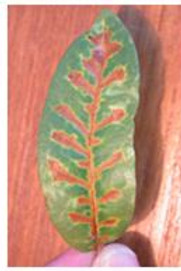Homeowners Association
San Antonio, Texas
one of San Antonio's most admired and desired communities for over 50 years.
Oak Wilt is a contagious fungal disease that can kill most species within just a few months. While an outbreak often starts with sap-seeking beetles which carry fungal spores from an infected tree to an open wound or fresh cut of a healthy tree, the disease then quickly spreads to nearby oaks via interconnected root systems at a rate of approximately 75 ft per year.
Once an outbreak starts it's nearly impossible to contain. Fungicide injections can avert death of most oak species, but the mortality rate without properly timed and administered treatment averages 90% for Live Oaks. Fungicide treatment is typically 4x less expensive than removing a dead tree, so WOHA encourages homeowners to be vigilant monitoring encroaching risk.
Selecting an Arborist. When risk of disease is suspected, consulting a specially trained arborist is strongly recommended. While most licensed arborists posses the standard ISA certification, only a handful serving Bexar County have also been certified by Texas A&M Forest Service to properly administer Oak Wilt fungicide. Click to view a partial list of such firms.
Fungicide Options. Fungicide is the only protocol scientifically verified by experts. Local arborists typically administer Propiconazole, which is recommended by Texas A&M Forest Service. It is a viscous liquid injected into the root flare via pressurized tanks. Some Whispering Oaks residents have experienced varying results with this formulation in recent years, even when administered professionally and with sufficient lead time.
When this occurs, some arborists may be willing to follow up with Tebuconazole which is an alternative formulation commonly used in other states which is less viscous and easier to administer. And while any follow up regimen should ideally be timed 12 - 18 after the initial, experts advise the risk of adverse reaction from a shorter interval is low and action may be necessary to save a symptomatic tree which is likely to die within months.
Preparation and Planning. Timing is critical. The goal is to treat at-risk trees before becoming symptomatic which indicates damage to the vascular system needed to effectively circulate fungicide. More than one application may be necessary over a period of time depending upon the threat's surrounding longevity and the tree's response.
Spring and Fall are the ideal time to administer because an oak's vascular system is most active in warm weather, but may then go dormant in a hot summer or cold winter. Experts recommend slow, steady root watering via soaker hoses well in advance of application to ensure the tree is sufficiently hydrated and primed to circulate the fungicide.
Remember, the disease can travel in-ground a significant distance annually and kills healthy oaks quickly. Monitor nearby properties and watch for symptomatic trees. But also talk to these neighbors because nearby treated trees may not show symptoms while still transferring the fungus to your oaks. If symptoms do appear, contact a qualified arborist immediately to avert tree damage and death.
Homeowner Responsibilities. In 2025, most Units within Whispering Oaks ratified amendments to the Community Covenants establishing a common sense mitigation policy:
-
Non-emergency pruning is prohibited during the risk high period of February through June. Removal of the entire tree may be conducted at any time.
-
All cuts must be sealed within 30 minutes. Homeowners are responsible to properly supervise their contractors.
-
Homeowners must promptly alert adjoining properties if the disease is discovered.
-
Dead or dying trees pose a safety risk and must be removed in a timely manner. Stumps visible from the street must be ground to soil level.

The Costly Threat of Oak Wilt
Map of Eastside Outbreak
The East side of Whispering Oaks has battled an outbreak for over a decade with moderate success (details here). Unfortunately, the disease is still progressing and has caught some residents off-guard, resulting in costly tree removal which can undermine a property's appeal and value.
WOHA partners with Texas A&M Forestry Service to track the outbreak which progresses approximately 75 feet each year. Agency staff update the map below at least once every two years. Data is collected via visual investigation, not chemical testing. This method of tracking is only an estimation because treated trees may not shown symptoms while still transmitting the fungus to nearby oaks. For this reason, WOHA gathers input from affected properties which may be reflected in the map.
The map identifies homeowners at increasing levels of risk who are urged to promptly discuss treatment options as described above. See legend for risk levels. Click map to enlarge or print.
Stay vigilant to avoid costly surprises.
Look periodically for signs of the disease in nearby properties.
Assess your level of risk by talking to neighbors.
Promptly consult an arborist when disease is found within 100 ft.

